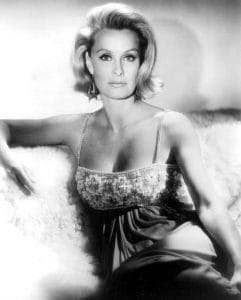Quite frankly, Merrill was born filthy rich: her mother was Marjorie Post — heiress to the General Foods (and Post cereal) fortune. Her father didn’t just work for the E.F. Hutton Manhattan brokerage, he founded it: he was, indeed, financier Edward Francis Hutton. As a child, Merrill vacationed in a home her parents built: Mar-a-Lago, the 58-bedroom, 33-bathroom Palm Beach, Florida, estate famous again because it’s now owned by Donald Trump. But Merrill wasn’t interested in the trappings of society: against her parents’ wishes, she dropped out of George Washington University and moved to the American Academy of Dramatic Arts: she wanted to become an actress. She changed her name to Merrill (ironically, after another stockbroker: Charles Merrill of Merrill-Lynch), and was so successful she was dubbed “Hollywood’s new Grace Kelly” (and had the looks to back that up — see below).

Merrill appeared in a wide variety of films, from A Nice Little Bank That Should Be Robbed (1958) to Jerry Lewis’s Don’t Give Up the Ship (1959), Operation Petticoat (1959), The Courtship of Eddie’s Father (1963), even Caddyshack II (1988) and the Hollywood parody The Player (1992), and many others in-between. Meanwhile, she had guest roles on such TV shows as Batman, Bonanza, The Love Boat, and The Nanny, as well as many Broadway plays. In 1966, when she divorced her husband (an heir to the Colgate-Palmolive fortune) to marry actor Cliff Robertson, Merrill was told she had been de-listed from the New York Social Register, a directory of the elite rich. She was shocked — she thought she had been de-listed long before. “It’s really so depressing to still be listed in the social register,” she said, “after all the acting I have done.” Merrill received a Lifetime Achievement Award from her alma mater in 2005, and died at her New York home on May 22 after suffering Lewy body dementia. She was 93.
